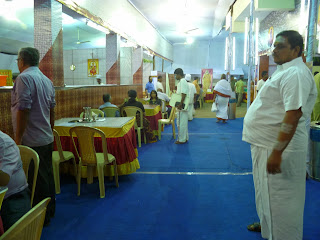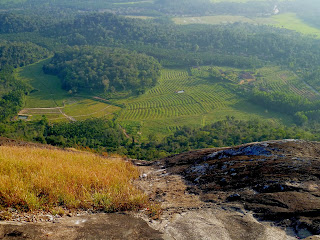Anywhere between three hundred to five concerts every day, without
break, for almost a month! Budding
artists, seasoned musicians, gods of music world, traditional, experimental,
fusion, solo, duet, vocal, instrumental, free entry, ticketed, closed
auditoriums, open air concerts - you
take your pick and enjoy Carnatic classical music to your heart content if you
can make it to Chennai for the annual music festival, called the ‘Margazhi Festival’, held during
December - January every year.
The concerts begin at ten in the morning and go on till nine
at night. Five to eight concerts in each of the nearly hundred venues every day. All the venues have attached canteen facilities running the whole
day. Have your breakfast and attend the first concert at Narada gana sabha, hop
onto a bus and reach Krishna gana sabha for the second concert and lunch, move
on to the music academy ( I believe a musician has ‘arrived’ if he is accepted
by the music academy and offered the prime slot in their AC auditorium equipped
with Bose sound system) for hot coffee and very attractive ‘meduvada’ and ‘wheat
halwa’ followed by the early evening concert
and end up at the Mylapore fine arts
club for the last one and dinner. Choose
the venues and artists depending on your taste, purse and ability to move. You
may stick to the free ones like the ISCON concert (Carnatica and Sri Parthasarathyswamy Sabha,
in association with Cleveland Tyagaraaja aradhana committee USA) and live on the
beach - the venue is almost on the beach
- the whole day. The weather is wonderful this time of the year and if you are
a frequent visitor to Chennai, it will be difficult to believe that you are in
Chennai and not sweating.
I believe music lovers come from all over the world, rent
rooms for a whole month and forget everything else during the period. We met a
Sikh gentleman, a resident of USA, at the music academy, who was on his twelfth visit
to Chennai for the music festival. A typical Sardarji replete with ‘Pagadi’ and
beard, fanatically interested in carnatic claasical music, speaking fluent
Telugu, Tamil and quite a bit of Kannada!
I had been hearing about the Margazhi festival from my
sister for many years and decided to experience it this time. I know nothing of
classical music, Carnatic or Hindustani, but I like listening to them. Just as
I like attending quizzes. I sit through three
hour quiz programmes without getting even one answer and most often not even
getting the question! It is almost the same with music. I will have no idea
whether the artist is singing/playing a Raaga, Varna or Kriti, (more
confusion if it is instrumental) but I enjoy them all the same.
I should thank the
Ramanavami concerts I used to attend in Bengaluru when I was young and in particular
Smt Srinivasamma and Sri Ranganathachar, an iyengar couple who lived near our
house, for what little inclination towards classical music I have developed. This
couple were the promoters of Carnatic Classical music in our locality without
any vested interest. They arranged at least a dozen concerts during Ramanavami festival
every year (over more than a decade as I remember) with the very active and even
more enthusiastic participation of Sri Srinivasa Raghavaachar, a music teacher
and their tenant. These concerts were held in a small hall built specially for
the purpose above their house and we were one of the regulars for the concerts.
Ramanavami usually falls in April after the final exams and we used to attend
those concerts in a blissful state of mind, free from the worries of home works
and tests. I don’t mind going through the primary school again if I can
get back that Ramanavami feeling once more. We sat through these concerts enjoying the popular
‘devaranamas’ which we could recognize and dozing when the recital turned technical.
Sri Srinivasa Raghvaachar, I guess, was a well respected gentleman in music circles and
we have witnessed well known artists like Asthana vidwan Titte Krishna iyengar
and Veena Doreswamy iyengar performing
in that small hall in front of an audience numbering not more than thirty.
I stayed in Chennai for three days during this 2013 season
and attended six concerts. Since I have no idea about the technicalities of
music I am unable to say anything about the quality of the concerts but can
provide a layman’s account along with the photographs.
 |
| schedule for the 2013 season at the Narada gana Sabha |
 |
| The first concert we attended. Violin duet By Vidwans Ganesh and Kumaresh. Narada Gana Sabha. |
Ganesh and Kumaresh. I heard these names
for the first time and I enjoyed the concert. I would have liked it better if
the antics were less. One of them was singing in between
and it was as good as his Violin.
 |
| How do they recognise sabha audience? From the look of bliss on their faces! |
 |
| Festival atmosphere in the canteen. Totally ethnic. And you know where the left overs, if any, go! |
On to the purely middle class Mylapore fine arts club. Vocal
recital by Sri T V Sankaranarayanan, again a new name for me. Madhurai Mani Iyer style. Fully traditional. I
just could not get the lyrics and could only guess whether it was Alaapana,
varna or Kriti based on the activity of the Mrindangam artist.
 |
| Vidwan T V Shankaranarayana |
 |
| what is 'Sumal' onion? My neice deciphered it as Tamil english for 'Small'. Bagala Bath of course is Bakala bath. |
 |
| Mandolin Srinivas, Rajesh |
The next day’s first concert was Mandolin U Srinivas at the
Krishna gana sabha, located in T Nagar. I had first heard about Srinivas more
than thirty years ago. He had made a public appearance when he was just about
ten years or so. I had had no opportunity to hear any of his concerts and this
was a good chance. Enjoyable concert but audience not very civilized.
 |
| Vidwan Vijay Siva |
From Krishna gana sabha we went on to Tyaga brahma gana
sabha to hear Vidwan Vijay siva, Vocal, yet another new name for me. The red light on top of my brother in law’s
car and the armed guard in the front seat, facilitated easy movement of the
vehicle (sometimes on the wrong side of the road - not for evading traffic and
arriving at the venue in time but for ‘security’ reasons) and allowed us to
alight in front of the main door from where we were escorted to the VIP seats
in the front row. I enjoyed the VIP treatment for two days because of my ‘Hoovina
jate naaru’ status. (a saying in Kannada which means - along with the flowers in
the garland the thread too reaches the god). I think I had ‘Rajayoga’ in my
horoscope though for a very short period, which helped me enjoy the concerts from
the VIP seats without the usual disturbance of people getting in and out.
The third day we attended two very lively concerts. One was
the vocal recital by OS Arun, one more new name for me. (most of the names were
new for me as I have hardly attended Carnatic concerts after leaving Bangalore
thirty years ago) It was at the ISCON temple with its sea facing stage. Vidwan Arun was in the middle of the very
popular kriti, Brochevarevarura, enjoying himself and almost dancing. And that
is what I felt like doing too when I heard it. He finished it about ten minutes after we reached there and I felt bad for having missed the earlier part.
 |
| Vidwan O S Arun |
 |
| ISCON almost open air. |
As if
to compensate for this loss, Kadri Gpoalanath, (again at the Tyaga brahma gana
sabha - with the reserved VIP seats) played the same on his saxophone, as the
main piece. I enjoyed this concert immensely as there were more ‘kritis’ which
I could recognise and many of them in Kannada! I think his Mangalore background
has something to do with it. Apart from providing great music, Kadri Gapalnath
was a sight to see with his bright coloured dress, jewellary and gold tipped
saxophone. He and his accompanying artists seemed to be able to read each
other’s minds and were enjoying themselves very much.
 |
| Kadri Gopalanath |
We were to leave Chennai in the afternoon on 18th
Dec and my sister insisted that we visit the Music Academy before we left. So I
had a chance to hear Udayalur Kalyanaraman’s ‘naamasankeertanam’ for a short
while. We could stay there just for half an hour and I think we created
considerable disturbance to others while we tried to pass through the rows to
get in and get out. We went to the canteen for a cup of coffee and saw people
enjoying an early lunch being served on plantain leaves. All the dishes looked
very attractive, meduvada and wheat halva the best. My sister had suggested
that we have lunch there but I had vetoed the suggestion because it would be
too early and we had more interesting items at home. After seeing the spread I felt that refusing
that lunch was not wise. (Photography not allowed at the Music Academy)
I should make it a point to take the canteens more seriously
if I go to Chennai again for the music festival. I may not be able to fully
appreciate the quality of the music, my case being something like the Telugu
saying “gaDdiku telasuna gandhala vasana” (can a Donkey appreciate the fragrance
of sandal wood?) but I can certainly appreciate the quality of eating that goes with the music in Chennai!








































